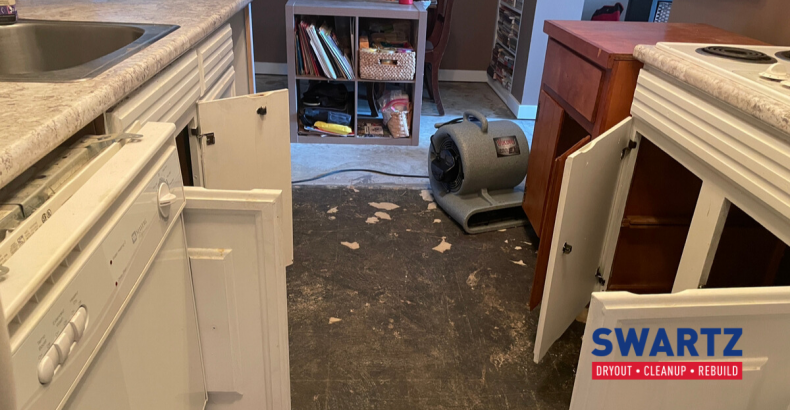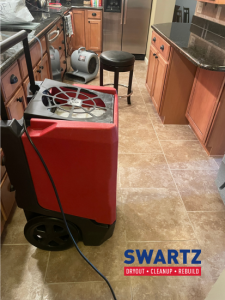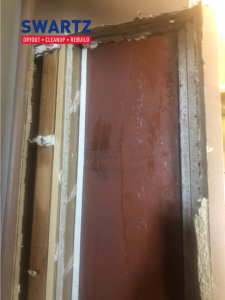
Water Damage Affected 6 Floors of Upscale Condominium in Lima
An upscale condominium building in Lima, OH had a water pipe break on the top floor this spring. Because water still flows downhill, it affected the condos directly below it on each floor. Six different condos were damaged from the one water pipe break on the top floor, and two hallways in the building were affected too.
Each condo had its own look, with different types of flooring and styles. Some had carpet, some had laminate, and some had tile. As the water soaked down through the ceilings, the walls and floors became saturated on each level. A plumber was called as soon as the leak was discovered, and he removed about 2″ of water from the building. Once he made the repair to the water supply line on the 7th floor, our water team came in to begin the dry-out process for each condo. Before starting, we received written permission from the condo association and each condo owner.
We began by extracting the excess water from the floors. Then we setup the drying equipment to dry out the rest of the water from the walls, floors and ceilings.


We returned the next day to monitor the equipment and make adjustments to continue drying things out. We removed any laminate flooring that was damaged, because once water gets underneath, it cannot be dried out. The way the flooring is designed, it holds any moisture underneath, and the wood particles begin to buckle as they soak it up.


Because each job is a little different, we didn’t know exactly what we would find as things began drying out. After the walls begin to dry, we are able to remove the baseboard and drill holes. We cannot do it immediately, or else it will cause more damage to the materials. Then we direct fans to those holes to allow airflow to reach behind the walls, causing the dry-out process to speed up.
There is often only one layer of drywall on each wall, yet we have seen two layers in some houses. In unit 403, as we drilled holes and cutout some damaged areas of the wall, we discovered 5 levels of drywall! It was a new record!!! It would have taken a long time to dry out those five layers if we had not cut or drilled holes in the water damaged areas.


When our team returned next, they removed more wet, damaged materials that were hindering the dry-out process. This job was unique because water came from the ceilings into each condo. Not only was there water damage to the walls and floors, but there was water damage to each ceiling as well. In the kitchen of unit 603, the cupboards were so damaged that we removed them completely. The ceiling and wall were able to be dried thoroughly and more quickly afterwards.


Many of the bathroom ceilings were saturated too, which required ventilation holes to help it dry them out.


By day 10 of this job, everything was dry in most of the units. Unit 701, where everything started, still had a few wet spots in the ceiling.
We never finish a job until everything is 100% dry, and we prove that with our moisture meters. From the beginning to the end of the project, we test the damaged building’s structure to determine how the dry-out process is going. That includes the ceiling, wall, and floor. As we monitor the dry-out process, these are the numbers that show us how the process is going. Yes, it is often visible when things are drying out, but the meters show us how dry the materials are when our eyes cannot see it.


This project required a lot of material to be removed, which means it requires a lot of restoration and rebuilding. Our team has put together an estimate for the repairs, and we have submitted it to the condo association’s insurance adjuster. Our estimate was approved, and we have a signed contract with the association. As of the writing of this, the rebuild process has not yet begun as we await materials and supplies to arrive.
